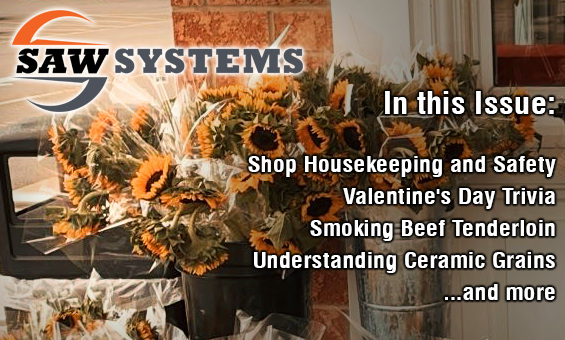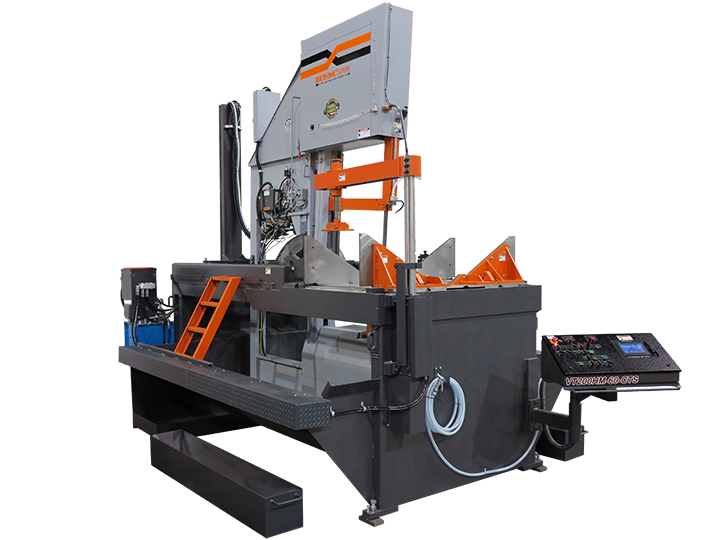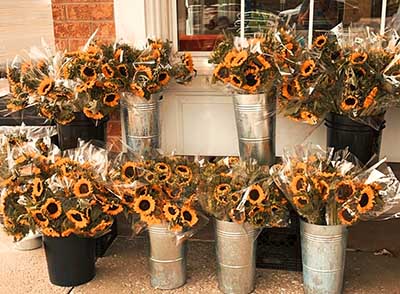
Welcome to the Saw Systems Newsletter. If you would like to share a story, request a story or just say, "hello," please Contact Us or call 800.966.1300

Welcome to the Saw Systems Newsletter. If you would like to share a story, request a story or just say, "hello," please Contact Us or call 800.966.1300
An article by OSH
Effective shop housekeeping can help control or eliminate workplace hazards. Poor housekeeping practices frequently contribute to incidents. If the sight of paper, debris, clutter and spills is accepted as normal, then other more serious hazards may be taken for granted.
Housekeeping is not just cleanliness. It includes keeping work areas neat and orderly, maintaining halls and floors free of slip and trip hazards, and removing of waste materials (e.g., paper, cardboard) and other fire hazards from work areas. It also requires paying attention to important details such as the layout of the whole workplace, aisle marking, the adequacy of storage facilities, and maintenance. Good housekeeping is also a basic part of incident and fire prevention.
Effective housekeeping is an ongoing operation: it is not a one-time or hit-and-miss cleanup done occasionally. Periodic "panic" cleanups are costly and ineffective in reducing incidents.
Poor housekeeping can be a cause of incidents, such as:
• tripping over loose objects on floors, stairs and platforms
• being hit by falling objects
• slipping on greasy, wet or dirty surfaces
• striking against projecting, poorly stacked items or misplaced material
• cutting, puncturing or tearing skin on hands or other body parts on projecting nails, wire or steel strapping
Effective housekeeping results in:
• reduced handling to ease the flow of materials
• fewer tripping and slipping incidents in clutter-free and spill-free work areas
• decreased fire hazards
• lower worker exposures to hazardous products (e.g. dusts, vapours)
• better control of tools and materials, including inventory and supplies
• more efficient equipment cleanup and maintenance
• better hygienic conditions leading to improved health
• more effective use of space
• reduced property damage by improving preventive maintenance
• less janitorial work
• improved morale
• improved productivity (tools and materials will be easy to find)
A good housekeeping program plans and manages the orderly storage and movement of materials from point of entry to exit. It includes a material flow plan to ensure minimal handling. The plan also makes sure that work areas are not used as storage areas by having workers move materials to and from work areas as needed. Part of the plan could include investing in extra bins and more frequent disposal.
The costs of this investment could be offset by the elimination of repeated handling of the same material and more effective use of the workers' time. Often, ineffective or insufficient storage planning results in materials being handled many times and being stored in hazardous ways. Knowing the workplace layout and the movement of materials throughout it will help when planning work procedures.
Worker training is an essential part of any good housekeeping program. Workers need to know how to work safely with the products they use. They also need to know how to protect other workers such as by posting signs (e.g., "Wet - Slippery Floor") and reporting any unusual conditions.
Housekeeping order is "maintained" not "achieved." Cleaning and organization must be done regularly, not just at the end of the shift. Integrating housekeeping into jobs can help ensure this is done. A good housekeeping program identifies and assigns responsibilities for the following:
• clean up during the shift
• day-to-day cleanup
• waste disposal
• removal of unused materials
• inspection to ensure cleanup is complete
Do not forget out-of-the-way places such as shelves, basements, sheds, and boiler rooms that would otherwise be overlooked.
The final step to any housekeeping program is inspection. It is the only way to check for deficiencies in the program so that changes can be made. Examples of checklists include inspecting offices and manufacturing facilities.
Spill Control:
The best way to control spills is to stop them before they happen. Regularly cleaning and maintaining machines and equipment is one way. Another is to use drip pans and guards where possible spills might occur. When spills do occur, it is important to clean them up immediately. Absorbent materials are useful for wiping up greasy, oily or other liquid spills. Used absorbents must be disposed of properly and safely.
Tools and Equipment:
Tool housekeeping is very important, whether in the tool room, on the rack, in the yard, or on the bench. Tools require suitable fixtures with marked locations to provide an orderly arrangement. Returning tools promptly after use reduces the chance of it being misplaced or lost. Workers should regularly inspect, clean and repair all tools and take any damaged or worn tools out of service.
Waste Disposal:
The regular collection, grading and sorting of scrap contribute to good housekeeping practices. It also makes it possible to separate materials that can be recycled from those going to waste disposal facilities.
Allowing material to build up on the floor wastes time and energy since additional time is required for cleaning it up. Placing scrap containers near where the waste is produced encourages orderly waste disposal and makes collection easier. All waste receptacles should be clearly labelled (e.g., recyclable glass, plastic, scrap metal, etc.).
Storage:
Good organization of stored materials is essential for overcoming material storage problems whether on a temporary or permanent basis. There will also be fewer strain injuries if the amount of handling is reduced, especially if less manual material handling is required. The location of the stockpiles should not interfere with work but they should still be readily available when required. Stored materials should allow at least one meter (or about three feet) of clear space under sprinkler heads.
Stacking cartons and drums on a firm foundation and cross tying them, where necessary, reduces the chance of their movement. Stored materials should not obstruct aisles, stairs, exits, fire equipment, emergency eyewash fountains, emergency showers, or first aid stations. All storage areas should be clearly marked.
Flammable, combustible, toxic and other hazardous materials should be stored in approved containers in designated areas that are appropriate for the different hazards that they pose. Storage of materials should meet all requirements specified in the fire codes and the regulations of environmental and occupational health and safety agencies in your jurisdiction.
by Amanda Hawkins and Hannah Jeon from Good Housekeeping
1. St. Valentine wasn’t just one person
2. Valentine’s day has its roots in ancient Pagan festival
3. In the 1300’s, it officially became the holiday associated with love
4. Cupid has its roots in Greek mythology
5. The first valentine was sent in the 15th century
6. Not until the 1840s did we get the first mass-produced valentines
7. The tradition of giving Valentine’s Day flowers dates back to the 17th century
8. Americans now spend millions of dollars on this day alone
9. Americans send 145 million Valentine’s Day cards each year
10. Americans also spend millions of dollars on gifts for their pets
11. The Valentine’s Day gift that peoples spend the most on is jewelry
12. The first heart shaped box of chocolates was introduced in 1861
13. Conversation hearts got their start as medical lozenges.
14. It wasn’t until 1866 that we first got sweet, printed messages on conversation hearts
15. More than 8 billion conversation hearts are manufactured each year
16. Nearly 6 million couples get engaged on Valentine’s Day
17. It’s celebrated differently around the world
18. "XOXO" didn’t always mean hugs and kisses
19. Kids can be the real Valentine’s Day winners
20. Lovebirds are actual birds
21. There is an official Valentine’s Day alternative for singles
22. William Shakespeare inspired a tradition

Whole beef tenderloin: take it out of the refrigerator and let it sit at room temperature for 30-45 minutes.
Use spray olive oil and coat meat lightly. Sprinkle dry Italian seasoning on the meat evenly on all sides.
Pre Heat grill/ smoker to high 500 plus degrees.
Sear meat on high temp for 6/mins a side.

Turn grill/ smoker down to 350 degrees and cook until 135-140 degrees internal temp for a hot medium rare. Let rest for 10 minutes under loose tin foil then slice.
You can trim the tail of the tenderloin off during cooking so it will not overcook, and have medium for those that like it that way…

ENJOY!
Understanding the unique properties of various products and grains can result in productivity gains
What makes ceramic grains unique?
Unlike other synthetically fused abrasive grains, ceramic grains are uniformly produced by a controlled chemical process to provide optimal strength and consistent properties. They are made in a way which creates thousands of fracture points throughout, ensuring consistent breakdown and life.
Unlike other synthetically fused abrasive grains, ceramic grains are uniformly produced by a controlled chemical process to provide optimal strength and consistent properties. They are made in a way which creates thousands of fracture points throughout, ensuring consistent breakdown and life.
How do they work?
The characteristic crystalline structure of ceramic grains provides numerous cutting points within each grain. Contact pressure will fracture weakened cutting points and expose fresh grain surfaces, effectively “self-sharpening” during use. Consider traditional aluminum oxide grains which dull and wear down to a rounded profile. This shape is no longer sharp and too blunt to cut effectively, acting more as a spoon than a knife.
• Thousands of cutting points
• Consistent fracture rate
• Continual self-sharpening
Quick Change Products Catalog
Premium - Light operator pressure, high temp applications, aggressive cut rate on hard or exotic alloys
Advantage - Medium operator compressor, Continual exposure of fine, sharp, cutting points, Top size reduces loading, glazing and dulling
Grinding Aid - Additional heat dissipation for high temp grinding, flexible x weight backing, extended life
Why do I use them?
The continual fracture rate of ceramic grains prolongs consistent performance and maintains sharp cutting points throughout product life, easily penetrating harder materials. The continual sharpening effect avoids dulling and glazing, both of which will cause overheating and premature wear.
Ceramic grains produce high stock removal rates on most materials, but added pressure is necessary for proper use. Softer materials do not provide enough resistance against the grains and will likely glaze. Or, an operator may combat the reduced fracture rate by overapplying pressure, resulting in unnecessary fatigue for both operator and product.
How to choose Ceramic Grains:
Proper selection of abrasive grains can realize efficient, and sometime surprising performance:
Each of our ceramic quick-change discs have unique properties and characteristics. Different materials also have very unique properties. To utilize ceramic products to the fullest, you must first determine if it is truly the best grain for your application. Ceramic grains require pressure to properly breakdown and realize efficiency. Harder metals, such as stainless steels, provide the resistance to fracture ceramic grains properly.
Consider the variables:
Depending on your process and final requirements, several options are available between our three ceramic grains. Take into consideration some of the variable properties and offerings of each ceramic grain.

See all features of the HE&M SAW VT 200 HM-60-CTS in this video (above)!
Capacity: 25" W x 36" H
Miter: 25" W x 25" @ 45°
Miter: 25" W x 17"@ 60°
Blade: 24’8" x 2" x .063"
Cant: 4° Fixed
Hydraulic Motor: 5 HP
Motor: 15 HP
Operation: Semi Automatic
STANDARD FEATURES INCLUDE:
• Adjustable Clamping Force
• Blade Brush
• Broken Blade Indicator
• Carbide Blade Guides
• Electronic Controlled Traverse (Controls Feed Rate & Cutting Force)
• Flood Coolant System w/ Wash-Down Hose
• Forward Cut Stop
• Full Stroking Main & 2nd Main Vise
• Power Raised Lift Up Rollers
• Powered Blade Tension
• Powered Chip Conveyor
• Powered Guide Arm
• Safety Guards
• Variable Blade Speed w/ Readout on Touch Screen
• Swing-Away Control Console w/ 7" Touch Screen
• Powered Programmable Tilt w/ Angle Readout
• 220V/440V/3PH Electrical Motor Requirement
OPTIONAL FEATURES
• 10′ Roller Discharge Table
• 10′ Roller Load Table
• 5′ Roller Discharge Table
• 5′ Roller Load Table
• Cut Watcher® System
• Laser Light System
• Pedestal Mounted Control Console
• Spray Mist Lubrication
• Swing-Away Top Clamp – Main Vise
• Material List w/ Larger 8" Touch Screen

"The harder you work for something, the greater you’ll feel when you achieve it"
Another shot by – © 2022 Abby Jensen
<— Click the tiny photo and then, to make it larger, click the arrow icon in the upper right corner of the window that pops up!
If you have a photo you’d like to share for your next newsletter, please forward it to us. If we use it, we’ll send you a little something. Click to Contact Us!